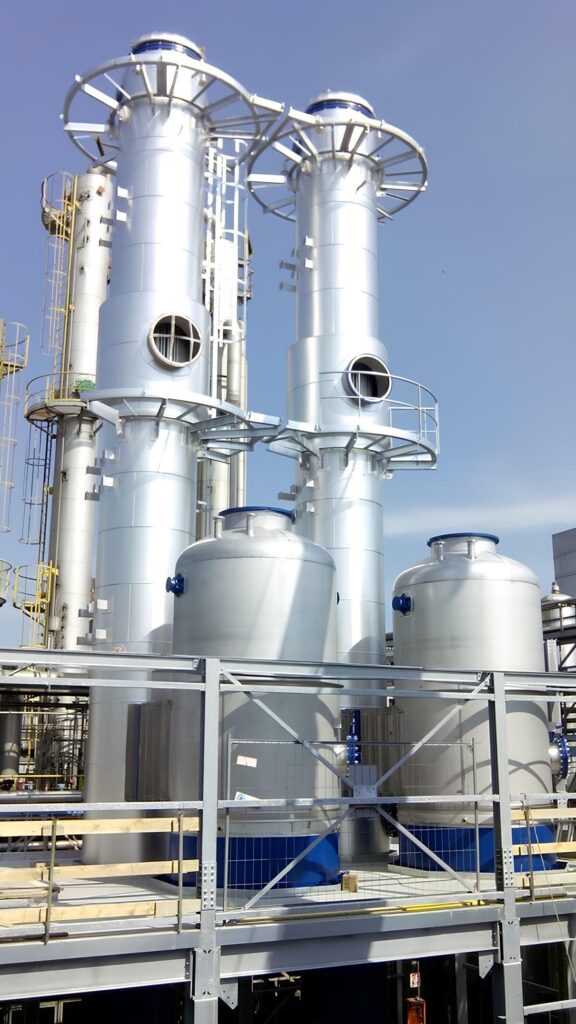In the increasingly heated debate on industrial sustainability, the choice of materials plays a crucial role. For companies like CITAL, engaged in the design and construction of industrial plants, the responsible selection of steel has become as much a strategic decision as a technical one. Today we want to share why our company has chosen – and continues to choose – stainless steel and its most advanced alloys, such as Duplex and Superduplex, as a cornerstone of our sustainable vision.
The Environmental Issue of Carbon Steel
The steel industry is responsible for about 7% of global greenhouse gas emissions and 11% of global CO₂ emissions. A significant portion of these emissions comes from the production and maintenance of carbon steel, a material traditionally used in many industrial sectors.
But there is more: the corrosion of carbon steel entails an additional environmental cost. According to a study published in Nature in 2022, indirect emissions related to replacing corroded steel could account for up to 9% of the sector’s total emissions by 2030. Moreover, the protective painting required involves the use of toxic substances, volatile organic compounds (VOCs), microplastics, and heavy metals, further contributing to environmental and watercourse pollution.
The Sustainable Alternative: Stainless Steel
In light of these issues, stainless steel clearly emerges as a far more sustainable choice from every perspective: environmental, social, and economic. It is 100% recyclable and has a lifespan that can exceed 100 years without the need for protective treatments, thanks to its natural resistance to corrosion. About 85% of stainless steel is recycled at the end of its life cycle.
Emissions from Stainless Steel
Stainless steel does generate emissions, but at a much lower scale. According to data from the International Stainless Steel Forum, the average production of 1 ton of stainless steel generates about 2.9 tons of CO₂. This figure includes:
· 1.92 tons from raw materials (e.g. nickel, chromium, molybdenum)
· 0.54 tons from electricity and steam
· 0.44 tons from direct emissions
However, the life cycle of stainless steel offsets these emissions thanks to its exceptional durability and the ability to be continuously recycled without quality loss.

CITAL and the Responsible Choice of Materials
At CITAL, we have long embarked on a conscious path: drastically reducing the use of carbon steel and prioritizing austenitic stainless steels (such as AISI 304 and 316), Duplex, and Superduplex. Only 7% of the sheets we processed between 2019 and 2022 were carbon steel. A technical decision, certainly, but also a deeply ethical one.
In particular, we work with suppliers such as Outokumpu, the world leader in low-impact stainless steel production. Their Circle Green line, for example, offers steel with a carbon footprint 92% lower than the industry average. Today, 70% of our stainless steel comes from them, with Circle Green available on request.
Environmental Benefits: Reducing the Ecological Footprint
Choosing stainless steel provides tangible benefits:
- Lower maintenance needs: thanks to the formation of a protective passive film, no toxic primers or paints are required.
- Extreme durability: many stainless steel plants exceed a century of service life.
- Closed life cycle: stainless steel is one of the most recycled materials in the world, ensuring a sustainable supply chain.
- Stable emissions over time: unlike carbon steel, which requires constant interventions and therefore new emissions, stainless steel maintains a stable footprint throughout its lifecycle.
Social Benefits: Health, Safety, and Quality of Life
Stainless steel is widely used in sectors such as food, pharmaceuticals, healthcare, and water treatment precisely because it is safe for both health and the environment. It does not release harmful substances and does not require dangerous protective treatments. Moreover, it improves quality of life: without stainless steel, many infrastructures that provide us with safe food, drinking water, and hygiene would be unthinkable.
Economic Benefits: Long-Term Savings
If we look only at the initial cost, carbon steel might appear more convenient. But a Life Cycle Costing analysis tells a different story. In the long term, stainless steel – especially Duplex alloys – proves more economical thanks to lower costs for maintenance, repairs, and plant downtime.
For example, a comparative study on a 20-meter diameter tank showed that materials in Duplex and 304L stainless steel have a significantly lower life cycle cost than their carbon steel equivalents.
An Industrial Strategy for the Future
The transition to more sustainable materials is not only a moral or environmental duty. It is also an opportunity for competitive and reputational positioning. Clients who are increasingly attentive to the ecological footprint of their suppliers reward companies capable of demonstrating conscious, future-oriented choices.
At CITAL, this vision is already a reality: our commitment to sustainable purchasing, the selection of cutting-edge suppliers, and emission reduction are an integral part of our business model.
Conclusion: Noble Steel, Noble Choice
Choosing noble steels such as stainless, Duplex, and Superduplex means investing in a cleaner, safer, and more sustainable future. It is an act of responsibility towards the environment, people, and future generations.
In a world racing towards decarbonization and the circular economy, the choice of material is no longer just a technical matter, but a declaration of intent. And we at CITAL have already made ours. Learn more about our sustainable projects at www.cital.it or contact us to discover how we can support your plant with stainless steel solutions.
References
Recommended citation: Hasanbeigi, A. 2022. Steel Climate Impact – An International Benchmarking of Energy and CO2 Intensities. Global Efficiency Intelligence. Florida, United States.
Garthwaite, J. (2021, April 16). The science behind decarbonization. Stanford Doerr School of Sustainability.
GOV.UK. (2022). Iron and Steel – Industrial Decarbonisation & Energy Efficiency Roadmaps to 2050. GOV.UK.
Total emissions 2013 Data provided by ISSF (2015)
Life cycle costing and Stainless Steel. SASSDA. (2021, September 16).
